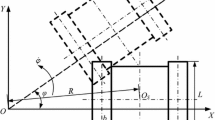Abstract
The electromechanical coupling performance of crawler machinery is investigated. A dynamic equation of electromechanical coupling of crawler machinery is established under multi-typical working conditions. The variation in performance of electromechanical parameters during unstable operations over time is analyzed using the virtual prototype and electromechanical coupling model of crawler machinery. The correctness of the electromechanical coupling model is confirmed by comparing the theoretical analysis, virtual prototype simulation, and physical prototype results. This study provides accurate and valuable theoretical methods and fundamental knowledge to analyze the electromechanical and road driving performance as well as to develop and design a crawler machinery.
Similar content being viewed by others
References
C. P. Bailo and C. J. Yen, Open modular architecture controls at GM powertrain: Technology and implementation, Photonics East'96. International Society for Optics and Photonics (1997) 52–63.
M. Consoni, F. Souza and M. Sacco, Analysis of electromechanical coupling facts of complicated electromechanical system, Trans. Nonferrous Met. Soc. China, 12 (2) (2002) 301–304.
T. Szolc et al., An investigation of the dynamic electromechanical coupling effects in machine drive systems driven by asynchronous motors, Mechanical Systems and Signal Processing, 49 (1) (2014) 118–134.
P. G. Benoit, Modelling of sinkage tests in tilled soils for mobility study, Soil & Tillage Research, 80 (2005) 215–231.
Q. Li, P. D. Ayers and A. B. Anderson, Modeling of terrain impact caused by tracked vehicles, Journal of Terramechanics, 44 (2007) 395–410.
T. D. Thai and T. Muro, Numerical analysis to predict turning characteristics of rigid suspension tracked vehicle, Jour–nal of Terramechanics, 36 (1999) 183–196.
J. Y. Wong and W. Huang, Wheels vs. tracks–A fundamental evaluation from the traction perspective, Journal of Terramechanics, 43 (2006) 27–42.
Y. Gao and J. Y. Wong, The development and validation of a computer–aided method for design evaluation of tracked vehicles with rigid links, Journal of Automobile Engineering, 208 (1994) 207–215.
D. Rubinstein and N. Galili, Rekem–A design–oriented simulation program for off–road track vehicle, Journal of Terramechanics, 31 (1994) 329–352.
D. Rubinstein and R. Hitron, A detailed multi–body model for dynamic simulation of off–road tracked vehicles, Journal of Terramechanics, 41 (2004) 163–173.
G. Ferretti and R. Girelli, Modelling and simulation of an agricultural tracked vehicle, Journal of Terramechanics, 36 (1999) 139–158.
Q. Li, Modeling of Terrain Impact Caused by Off–road Vehicles, Knoxville, Tennessee, US: The University of Tennessee (2006).
G. Alexandr, Thrust and slip of a track determined by the compression–sliding approach, Journal of Terramechanics, 44 (2007) 451–459.
K. Hun, J. Choi and H. Yoo, Development of a multi–body Dynamics simulation tool for tracked vehicles: (Part II, Application to track tension controller design): Special issue on multibody dynamics, JSME International Journal. Series C, Mechanical Systems, Machine Elements and Manufacturing, 46 (2) (2003) 550–556.
N. Ma and D. Wang, Study on propagation of electromechanical disturbance in power systems based on distributed fluid network, Power System Technology, 37 (5) (2013) 1353–1358.
S. Chen, Y. Zhang, S. Lin and Z. Fu, Study on the electromechanical coupling coefficient of Rayleigh–type surface acoustic waves in semi–infinite piezoelectrics/nonpiezoelectrics superlattices, Ultrasonics, 54 (2014) 604–608.
W. Merhof and E. M. Hackbarth, Fahrmechanik der Kettenfahrzeuge, Leuchtturm–Verlag (1985).
J. Cao, Q. Wang and H. Dai, Electromechanical properties of metallic, quasimetallic, and semiconducting carbon nanotubes under stretching, Physical Review Letters, 90 (15) (2003) 157601.
Author information
Authors and Affiliations
Corresponding author
Additional information
Recommended by Associate Editor Cheolung Cheong
Guanyu Zhang received the Ph.D. degree from Jilin University, Jilin, China, in 2015. He is now working in College of Instrumentation and Electrical Engineering, Jilin University as a teacher. His current research interests cover global optimization design and mechatronics, mechanical-electrical integration. He has published more than 8 papers in international journals.
Rights and permissions
About this article
Cite this article
Ji, Y., Lv, X., Zhang, L. et al. Electromechanical coupling modeling simulation and experimental study of crawler. J Mech Sci Technol 33, 857–868 (2019). https://doi.org/10.1007/s12206-019-0143-2
Received:
Revised:
Accepted:
Published:
Issue Date:
DOI: https://doi.org/10.1007/s12206-019-0143-2



